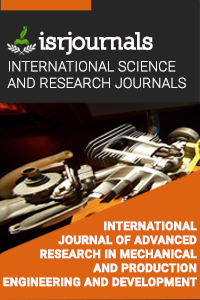supply chain management study in drug manufacturing
M.SASHI KUMAR,Dr.BHARAT M RAMANI,A.ANANDA KUMARI
Published in International Journal of Advanced Research in Mechanical and Production Engineering and Development
ISSN: 2320-7256 Impact Factor:1.398 Volume:1 Issue:3 Year: 11 December,2011 Pages:158-162

Abstract
Supply Chain Management (SCM) practices can significantly impact one aspect of organizational outcomes, i.e., customer satisfaction of drug manufacturers in the pharmaceutical industry. This study, therefore, seeks to find out the influencing dimensions of SCM practices and examine empirically the conceptual framework of proposed relationships between these dimensions and customer satisfaction. A quantitative survey was carried out among the managers and executives of various drug manufacturers in the pharmaceutical industry of Bangladesh. The results of the study indicate that SCM practices as observed in the industry comprise three dimensions, namely, collaboration and information sharing, logistics design and IT infrastructure, and organizational culture (OC). However, while the first two exert their impact on customer satisfaction, OC does not have any influence on it. Research limitations: The study is performed only in a particular industry and with a questionnaire survey. Future studies could extend the findings covering other industries as well as conducting a qualitative exploration of the pertinent dimensions of SCM practices. The findings of the study have a significant bearing for the managers working in pharmaceutical industry. The dimensions and their constituent items offer a significant insight into the current SCM practices impacting customer satisfaction and room for potential improvements in this regard. Originality/value: Few studies have been done on the influence of SCM practices on customer satisfaction in pharmaceutical industry in the context of a developing country. Besides, there is a dearth of large scale empirical investigation in this particular area.
Kewords
Manufacturing,infrastructure,Machinery,Production.
Reference
[1]. Buxbaum, P.A. (1995), “The horizontal company”,Transportation and Distribution, June, pp. 36, 82. [2]. Coombs, R. and Hull, R. (1996), “The wider research context of business process analysis”, working paper, Center for Research on Organizations, Management and Technical Change, Manchester School of Management, Manchester. [3]Davenport, T.H. and Short, J.E. (1990), “The new industrial engineering: information technology and business process redesign”, Sloan Management Review, Vol. 31 No. 4, pp. 11-27. [4]. Day, G.S. (1994), “The capabilities of market-driven organizations”, Journal of Marketing, October, pp. 37-52. [5]. Dorfman, M. and Thayer, R.H. (1997), “The capability maturity model for software”, in Dorfman, M. and Thayer, R.H. (Eds), Software Engineering, IEEE Computer Society Press, Los Alamitos, CA, pp. 427-38. [6]. Grover, V., Jeong, S.R., Kettinger, W.J. and Teng, J.T.C. (1995), “The implementation of business process reengineering”, Journal of Management Information Systems, Vol. 12 No. 1, pp. 109-44. [7]. Hammer, M. (1996), Beyond Reengineering: How the Process Centered Organization Is Changing Our Lives, HarperBusiness, New York, NY. [8]. Hammer, M. (1999), “How process enterprises really work”, Harvard Business Review, Vol. 77 No. 6, pp. 108-18. [9]. Hammer, M. and Champy, J. (1993), Reengineering the Corporation: A Manifesto for Business Revolution, 1st ed., HarperBusiness, New York, NY. [10]. Harter, D.E., Krishnan, M.S. and Slaughter, S.A. (2000), “Effects of process maturity on quality, cycle time and effort in software product development”, Management Science, Vol. 46 No. 4, pp. 451-66. [11]. Ibbs, C.W. and Kwak, Y.H. (2000), “Assessing project management maturity”, Project Management Journal, Vol. 31 No. 1, pp. 32-43. [12]. McCormack, K. and Johnson, W. (2000), Business Process Orientation: Gaining the E-Business Competitive Advantage, St Lucie Press, Delray Beach, FL. [13]. Porter, M.E. (1985), Competitive Advantage: Creating and Sustaining Superior Performance, Free Press, New York, NY. [14]. Software Engineering Institute (2002), “The rational unified process and the capability maturity model”, Software Engineering Institute, Carnegie Mellon University, Pittsburgh, PA, available at: www.sei.cmu.edu/cmmi/presentations/rup.pdf [15]. Walton, M. (1986), The Deming Management Method, Perigee Books, New York, NY.

